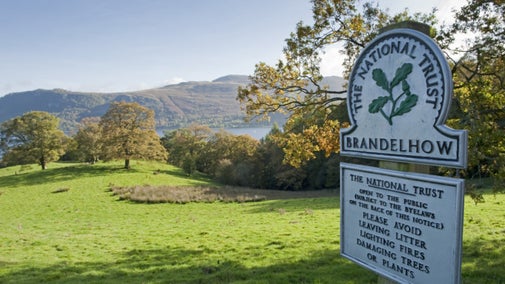
People in history
Discover some of the social history behind the places we care for and uncover fascinating facts about the people who have lived in them.


One of the three founders of the National Trust, Octavia Hill was a pioneering thinker and social reformer. She worked tirelessly to improve urban housing and to protect green spaces and the impact of her life and work is still being felt. Her belief in the importance of access to nature for human wellbeing and the need to stop the destruction of the natural landscape are even more relevant today.
One of nine children, Octavia was born on 3 December 1838 at Wisbech in Cambridgeshire.
Both of her parents were keen social reformers and followers of Robert Owen, a founder of utopian socialism. They opened the Wisbech Infant School as ‘a service to the wretched poor’ and encouraged its use as a ‘Hall for the People’ in the evenings, with lectures, dances and meetings of the Mental Improvement Society held there.
Initially they lived in a comfortable townhouse, however all this changed when Octavia’s father was declared bankrupt after his investments failed. He fell into depression and subsequently abandoned his wife and children.
Octavia’s mother took charge of the family, moving them to London and taking a job, and encouraged her daughters to do likewise.
Octavia’s first job at the age of 14 put her in charge of a workroom at the Ladies Guild, a Christian socialist co-operative in London managed by her mother. Seeing the poverty of the girls at the school had a profound effect on her.
Her encounters with prominent thinkers, like radical clergyman F. D. Maurice, campaigning author Charles Kingsley, and unorthodox intellectual John Ruskin, supported her ideals. Inspired by their ideas, Octavia set out to improve working-class living conditions.
In 1864, money from Ruskin enabled Hill to put her ideas into practice. She began buying neglected and decaying properties in London: overhauling them and transforming their tenants’ lives. She also campaigned to preserve open spaces.
She was firm in her style of management, insisting that all the tenants paid their rent on time, but she also took a personal interest in their lives. As her biographer Peter Clayton puts it, ‘She became the friendly face of "landlordism" … Her methods were firm but compassionate: she patiently fostered a reciprocal respect between landlord and tenant.’
Her scheme was a success and rapidly expanded with new investors. By 1874 Octavia had over 3,000 tenancies around London.

Octavia closely connected cultural philanthropy to social reform and her growing portfolio of houses became hubs of creativity, with music lessons, cultural outings, and Gilbert and Sullivan performances.
In 1877, along with her sister Miranda, she formed the Kyrle Society, with the aim of bringing beauty, nature, arts and music to everyone.
Octavia became convinced of the need for open spaces for the urban masses. She joined a campaign to save Swiss Cottage Fields from development and although it eventually failed, it was through it that she met Robert Hunter, solicitor for the Commons Preservation Society.
They successfully campaigned together to resist development on Parliament Hill Fields, Vauxhall Park and Hilly Fields in London. Ultimately, along with Hardwicke Rawnsley, they went on to found the National Trust for Places of Historic Interest or Natural Beauty in 1895.
For the next 17 years until her death in 1912 Octavia continued to fight for the preservation of the countryside. She helped the National Trust to buy and protect its first land and houses and campaigned for the preservation of footpaths to ensure everyone had right of access to the land.
We all want quiet. We all want beauty…we all need space.
Octavia was a determined and strong-minded person and some of her views are controversial today. She was, for example, against a welfare state giving out free school meals, council housing and a universal old-age pension. She argued instead that private enterprise and charity could solve social inequality.
However, her holistic view of human needs and her willingness to act upon her beliefs sparked a real change that can still be felt today. Octavia Housing continues to provide homes for thousands of people in inner-city London and in 2020 the National Trust celebrated its 125th anniversary.
Thanks to Octavia’s vision and the generous donations of supporters, we now care for over 250,000 hectares of farmland, 780 miles of coastline and 500 historic properties, gardens and nature reserves, for everyone, for ever.
This article contains information written by William Whyte, Professor of Social and Architectural History and a fellow of St John’s College at the University of Oxford. William is the author of Oxford Jackson (2006), Redbrick: A Social and Architectural History of Britain’s Civic Universities (2015), and Unlocking the Church: the Lost Secrets of Victorian Sacred Space (2017).

Discover some of the social history behind the places we care for and uncover fascinating facts about the people who have lived in them.

A hub for multi-disciplinary research projects and research engagement at the University of Oxford
Find out more about our Trusted Source articles, which were created in partnership with the University of Oxford, and explore topics related to the special places in our care.

Find out about the work of Robert Hunter and how his job as a solicitor helped shape the National Trust.

As well as a founder of the National Trust, Hardwicke Rawnsley was a religious man, writer, social reformer and active campaigner for the protection of the Lake District.

Discover the history of the National Trust, from its foundation in the 19th century, through key projects, wartime and epidemics, to the modern day.

Find out more about Octavia Hill, Robert Hunter and Hardwicke Rawnsley in our book.
